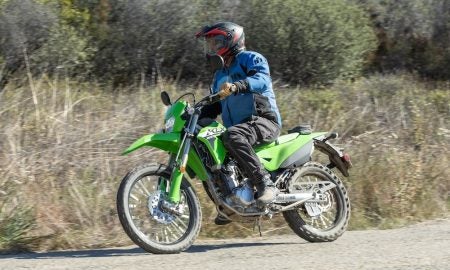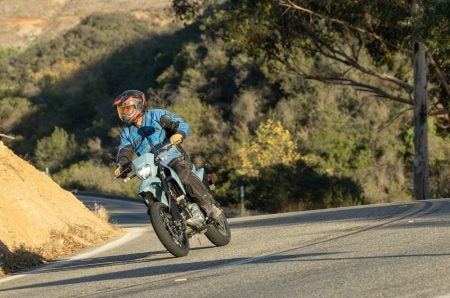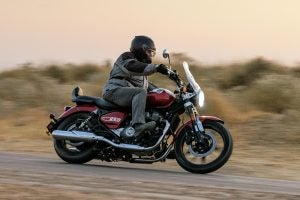We at ADVRider are unapologetic fans of the Kawasaki KLX300. David Hilgendorf gave it a positive review during its 2021 introduction, and Zac echoed those sentiments when he got his hands on one. Besides the fuel-injected 292 cc engine, other upgrades from the previous KLX250 were fairly minor, despite its already long run. Kawasaki seems to be following Mark Twain’s advice, making continuous improvements to a great platform rather than reinventing the wheel. The 2024 Kawasaki KLX300 continues this trend, again with several minor updates rather than an all-new design. After almost 20 years, is the KLX platform getting long in the tooth, or is Kawasaki still on the right track with its ongoing evolution? I attended the press launch of the updated model to find out.
What’s New?

Photo: Kevin Wing
The differences between the 2024 Kawasaki KLX300 and earlier models are minor but welcome. We were surprised the 2021 model didn’t already have an LED headlight, but now it does, helping prevent the dead batteries and push-starts we encountered on our previous press ride. While our rides did push the limits of the short December daylight hours, I wasn’t able to see just how well the new headlight worked in complete darkness.
The other changes are mainly cosmetic, inspired by the off-road KX models. The new shrouds are longer and 25 mm slimmer, giving the rider a little more room to maneuver, particularly while cornering. It has a two-tone seat, new front and rear fenders, and a new tail light, losing the appearance of a small KLR650 in favor of a more modern look. Though not visible, the ignition lock is also new, using five tumblers instead of three for better security, something the Lock Picking Lawyer would appreciate. These updates apply to both the dual-sport and supermoto versions.

Photo: Kevin Wing
It’s worth noting that the supermoto version now gets the same fenders as the dual-sport, as well as the same round mirrors. Some might criticize this as a cost-cutting measure, but the mirrors, at least, are a positive change. The supermoto’s previous mirrors, while more stylish, we found quite susceptible to vibration and wind movements. Swapping to the solid, steady round mirrors of the dual-sport fixes this problem.
Beyond these small tweaks, the KLX300 hasn’t fundamentally changed. It has the same engine, suspension, and brakes as before. Appearance aside, I got pretty much the same riding experience as our previous testers. The main difference is that while our previous testers are rather experienced dirt riders, I’m still fairly new to leaving the pavement behind. I learned the basics on a KLR650 and have pretty much stayed out of trouble on my V-Strom, so I was interested in learning what a smaller dual-sport can do.
Sure-Footed, No Matter What

Photo: Kevin Wing
My first experience with the KLX300 was taking it straight onto the motocross course at Blackwood Ranch. Sadly, I wasn’t one of those kids born on a dirt bike. In fact, this was my first time ever on a motocross course. After a few laps to get familiar with the bike and the track, I was already confident enough to try new things I’d never done before. While I didn’t catch big air over the tabletop jump like some of the other journalists who adeptly rode it like a motocross machine, I did catch some air, something I’d rarely done before.
What surprised me most was how good the stock suspension is. I chose my particular used KLR because it came equipped with a full Cogent Dynamics suspension, a significant improvement over the stock KLRs I’ve ridden.
This bone stock KLX felt even better than that. Some of that was its lighter weight, I’m sure, but credit also goes to its 43 mm inverted front forks with 10 inches of travel and Uni-Trak rear suspension with 9.1 inches of travel. I didn’t even play with the 16 compression adjustments in front or the 20 compression and 30 rebound adjustments in the rear. It just worked, straight out of the box. If I owned this bike, I could take advantage of these adjustments as my skills improved and I learned how to get the most out of it. The fact that others rode the KLX like a motocross bike and it took everything they could throw at it speaks well of its durability.

Photo: Kevin Wing
I’d only visited an OHV riding area once before, on my KLR650, and soon found myself in over my head. The KLX300 was a different story. I found myself tackling more difficult terrain than I’d ever attempted before, and doing so with ease. While I did drop the bike once, it was my fault for hesitating at an intersection and allowing the bike to tip over. If I’d been confident in which direction to turn, I would’ve been fine. The tip of the brake lever snapped off due to the lack of hand guards, but there was plenty of lever left to complete the ride without difficulty. I install hand guards and a bash plate on any bike I own and take off-road, which would have prevented this damage had the KLX been equipped with them from the factory. Although I had not planned to test how difficult the KLX300 is to pick up after a drop, I can say that it was quite easy, even on the uneven ground I tipped over on. I could pick up it several times on a difficult ride if I had to.
While Dork in the Road makes fun of himself for overusing the phrase “confidence-inspiring,” that’s exactly the phrase I must apply to the KLX300. Even with its limitations, the bike was far more capable than I was, enabling me to achieve constant success and build the confidence to try even more challenging terrain. I was confident that my KLR would survive all of my mistakes, but the KLX gave me the confidence and encouragement to go out there, try new things, and enjoy them, not just survive them. By the time the dual-sport ride was over, I wished that I had started my off-road journey on the smaller, easier-to-ride KLX300 instead of my bigger, heavier KLR650.

Photo: Kevin Wing
The KLR is still the better road bike, but the KLX was perfectly fine on the street. During our ride, it hit 65 mph with power to spare, and the stock Dunlop D605 tires felt firmly planted instead of vaguely connected to the pavement like some other DOT knobbies I’ve tried. You can certainly ride the KLX300 to the trailhead, spend a few hours tackling trails, and then ride home. I wouldn’t want to do any long-distance touring on it. My six-foot-tall body felt slightly cramped at the end of the day, and the seat, despite its new look, was not comfortable for a long day in the saddle. That’s what the larger, more comfortable KLR is for. The KLX is better for shorter hops, and far more capable when the going gets tough.
Savvy the Supermoto

Photo: Kevin Wing
Speaking of street riding, I should discuss the KLX300SM. I’d never understood the point of a supermoto. Why take a perfectly good dual-sport, and then customize it for the street? That formula seemed about as effective as a mall-crawler Jeep that will never see dirt. I approached the KLX300SM with an open mind, though. I genuinely wanted to understand it, and not knock it until I tried it.

Photo: Kevin Wing
After a few hours on it, I understood. It reminded me of the Mazda Miata I used to drive in autocross and track day events. Both have low-power, high-revving engines, great handling, and excellent grip, thanks to the 17-inch IRC Road Winner tires in the case of the KLX300SM. A sport bike, or even my V-Strom would’ve been faster, no question. But they would not have been as fun as the high revs, gobs of throttle, and satisfaction that came from riding the perfect lines through the twisties on the KLX at or around the 55 mph speed limit through southern California wine country. Miata owners like to say, “It’s more fun to drive a slow car fast than to drive a fast car slow.” After riding the KLX300SM, I believe that saying applies to it, as well. I would personally choose the dual-sport version for its off-road capabilities since that’s where my interests lie, but now I understand the appeal of the supermoto. I thoroughly enjoyed an afternoon carving the canyons on this little beast.
Continuous Improvement

Photo: Kevin Wing
The Kawasaki KLX300 did not exist in Mark Twain’s time, but his statement about continuous improvement being superior to delayed perfection applies quite well to it. It was not a perfect bike when it came out. It is not a perfect bike today. When it comes to performance, it doesn’t hold a candle to some of the rip-roaring small dual-sports from Europe. It’s also not intended to. Kawasaki is building the KLX300 to a price point that places it well within the grasp of most riders. It may not keep up with a KTM 350 EXC-F, but starting at $6,199, it’s half the price. You don’t get half the performance, either. The power is adequate, the brakes are good, and unlike many dual-sports the stock suspension is excellent. The KLX300 remains an excellent bike to enter the world of dirt riding and still offers the more advanced rider plenty to enjoy as well. Someday Kawasaki will have to introduce an all-new small dual-sport to replace the current KLX300 and keep up with the competition, but that day is not today.







